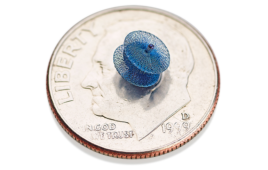
The Molli Marker magnetic implant is 3.2 mm long. [Photo courtesy of Molli]
The Toronto-based company’s latest products are Molli 2 and Re.markable, launched in April 2023.
Molli 2 is the second-generation locator system for pinpointing the Molli Marker, a tiny, magnetic implant placed for surgical site localization with the Molli Introducer needle. Molli says its marker is the smallest on the market at just 3.2 mm in length.
Molli Re.markable, meanwhile, is the magnetic technology used to retrieve the marker if needed for a second, more accurate marker placement.

Molli Surgical’s co-founders are CEO and President Ananth Ravi and Chief Technology Officer John Dillon. [Photo courtesy of Molli Surgical]
These implanted markers are traditionally removed during surgery along with the targeted tissue. But there was no good way to remove an imprecisely placed marker before a surgery. Instead, a surgeon would just place a second marker and remove them both with the affected tissue.
Wire markers, for comparison, are easier to remove and replace. But the placement procedure can be uncomfortable for patients — the wires secure themselves using a barbed hook beneath the skin — and in extremely rare cases can cause a collapsed lung. The wires are usually placed on the same day as the surgery to minimize patient discomfort, the risk of bleeding and marker migration.

The Molli Re.markable device (left) for removing the magnetic Molli Marker is the same size as the Molli Introducer (right) used to place the marker beneath a patient’s skin. [Image courtesy of Molli Surgical]
Drawn to magnets
Molli explored electromagnetic technology, infrared and a number of other techniques before honing in on magnets.
“With electromagnetic tracking or any of these other components, you have an antenna that sends out a pulse and then listens to an echo. Anything around it distorts the environment, you have distortion effects and all of these things that really become quite cumbersome to deal with and the complexity starts to ratchet very quickly,” Ravi said. “In our mind, we were like, ‘Why are we dealing with something that’s a pulse and sending out something and listening to echo? Why can’t we just listen?'”
The magnet’s permanent magnetic field means there’s no need for the implant to be powered or have any other components beyond the magnet.
“That allowed us to simplify a lot of our design elements,” he said. “And it also made it incredibly robust, because a solid core magnet is indestructible, it’s not going to break, and it’s always going to provide a signal. That level of reliability really resonates well with surgeons who are counting on this technology to work when they need it most.”

The Molli 2 lesion localization platform locates the Molli Marker with a wand and displays its location on a tablet. [Photo courtesy of Molli Surgical]
“The secret sauce is really around in how you calculate this with robustness,” Ravi said, though he declined to go into detail for competitive reasons. “Taking all that information and then distilling it into a simplistic user interface is where we pride the ingenuity of our engineering team.”
Keep it simple
That simplicity is crucial. Molli tested with dozens of surgeons to make sure the information on display wouldn’t be overwhelming or distracting.
“You want to simplify down to something that’s accessible and just the right amount of information at the right time for the surgeon,” he said. “… We obsess over those details to make sure that the interfaces are simple and easily used. We’re not presenting so much information that it’s confusing. We’re not presenting less than what’s absolutely required.”
It’s not always easy to resist the urge to show off complexity, but Ravi encouraged engineers to start with the user’s fundamental need and design for that outcome.
“Once you start presenting more while it’s totally doable you will start to distract from the bare essence and there’s risk in that. That cognitive fatigue can result in errors,” Ravi said. “The purpose of engineering complexity is to simplify. It’s not to show the cleverness of the solution.”
Look for more from Molli in the months and years ahead.
“We’re committed to launching new products every 12 to 18 months. But to do that, you have to make some bold bets sometimes,” Ravi said. “There are ways to make these bold bets with a measured type of study and testing. You just continuously de-risk initiatives. so by the time you get to the FDA and by the time you’re doing ISO-level studies and tests, your entire project’s fully de-risked and then your pathway to clearance is seamless.”




